Chip surprised both the Wildcats and me in this game! A major component of what makes Chip Kelly so successful is not just how he coaches the spread offense and runs a rapid “no-huddle” tempo, but also how he brings something new to nearly every game he coaches. It is the last major area the media have not understood or covered, and we at FishDuck.com have been explaining it for two seasons now.
If an NFL fan wants to know how Chip wins — then this is an analysis to study. For us Oregon fans? It is our last opportunity of this season to savor what coach Kelly throws at an opponent as we learn about the surprise “throwback” Fiesta bowl strategy that made a big difference in our BCS bowl triumph.
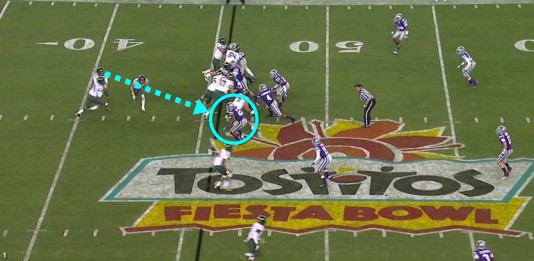
Early in the game (above) we see our QB zone read the Kansas State defensive end who ”sat,” meaning he remained in his zone to prevent Marcus Mariota from pulling the ball on the mesh and running up the backside of the defense. Note that the DE is about two yards from the hash mark, defending the gap from that spot.
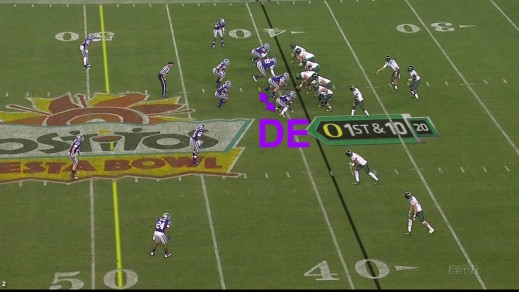
Later in the game (above) we see the Wildcat right defensive end stationed between two and three yards from the hash marks where the ball is being snapped. This is typical alignment for defenders, but I point it out as a starting place to help us see the play that develops.
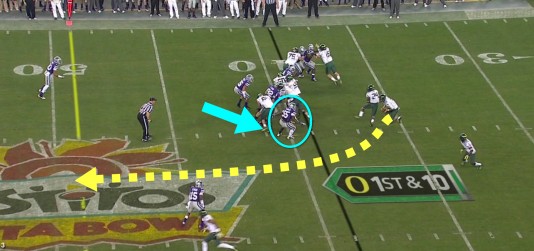
As the game proceeds, these defensive ends often get antsy and want to be in on the tackle, so they begin sliding down the LOS to get closer to the ball. In this example (above) we see that Marcus has pulled the ball BECAUSE K-State’s defensive end has slid so far inside. Look where he is! He is all the way to the hash marks, which was the middle of the line when the play began. Mariota knows that when they slide down that far and lean inside, he can pull the ball and run outside.
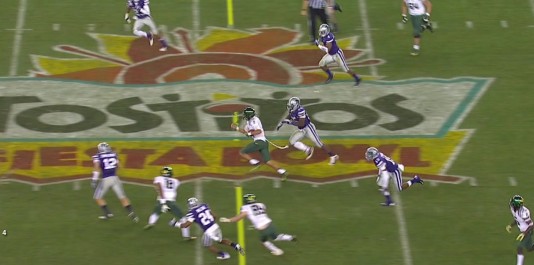
We recall the result: Mariota gashed the Wildcat defense for over thirty yards on this play (above) when he noted the positioning of the defensive end. This is higher-level zone reading by the QB. It happens in split seconds and is the result of thousands of repetitions in practice. A play like this is WHY we started FishDuck.com, as it was not explained correctly in the telecast this time, typical of too many other occasions.
We became frustrated with five years of watching the spread offense without adequate explanations from the sources that are paid to provide analysis. Hence, we offer this to you for free.
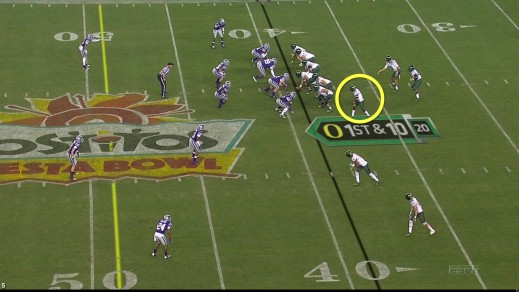
That last play was like any other Inside Zone Read…right? Wrong. Look at the positioning of DeAnthony Thomas at the beginning of the play (above). In the slot, he MUST be guarded carefully as a pass receiver.
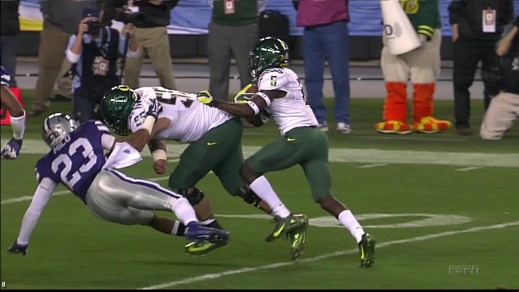
Defenses must watch DAT closely or he will catch a pass, get a good block in open field (above) from teammate Hroniss Grasu, and be off for another touchdown. Thomas is deadly in the open field and must be accounted for downfield to prevent the explosion plays against the defense. Usually the defensive backs offer a “soft cover” where they give themselves a big cushion head start to try to keep up with one of the fastest players in college football.
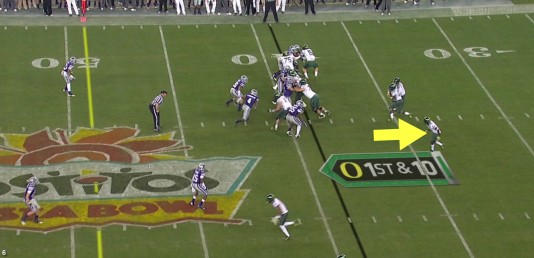
Going back to the beginning of the play (above), I could scarcely believe my eyes to see DeAnthony Thomas BACK-PEDALING from his slot spot? He truly ran backwards to where you see him now!

It becomes apparent (above) that this play turned into a Straddled Triple Option where DAT became the pitchman! When I say, “straddled,” I point out that we ran an Inside Zone Read to the right, and a speed double option to the left where Thomas backed up from his slot WR position to becoming a pitchman! This is a new wrinkle, and it is what created the lane for Mariota to run through between the defender guarding DAT (violet circle) and the chasing defenders.
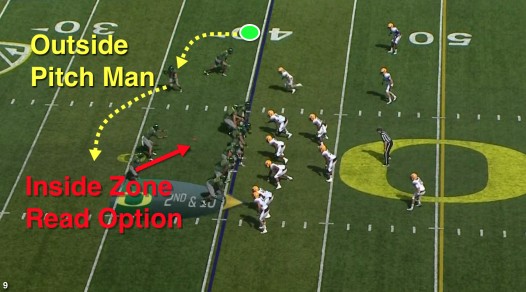
We have had two standard ways to attack defenses with the Straddled Triple Option. The first (above) is what I saw the most in Chip Kelly’s first years here. The split end or flanker goes in motion to become the pitchman.
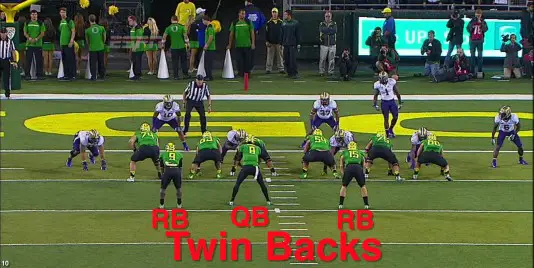
The alignment above is the most frequent method of running the Straddled Triple Option with the twin running backs to each side of the QB. You can go either direction with one RB being the Inside Zone Read option and the other being the pitchman. Thus the defense must line up balanced, as they don’t know which direction we are attacking. (Before some of you howl that one of the RBs above is Colt Lyerla, we DID have plays where he carried the ball as a RB. In fact, one time he carried the ball AND the QB into the end zone!)
I presented an analysis last week that featured the “Power Read” play that Chip pulled out. He had not used this confusing play since the seventh game of the season, and used it to surprise Kansas State. Considering all the tactics that Coach Kelly shows over the year…how do opposing defensive coordinators know what to prepare for? The “Power-Read” was used in one game in 2011 (Cal) and then pulled out for one game in 2012 (Washington). You simply cannot waste practice time on guessing what Kelly will present, so you just practice for what he called in the last game or two.
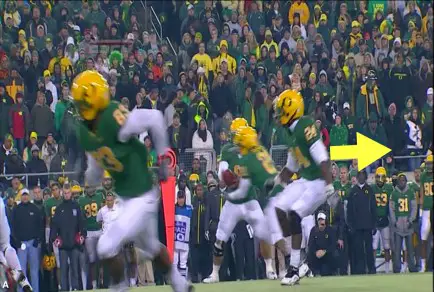 Most would say that pulling a play from earlier in the season is hardly a “throwback,” but look at the screenshot to the right, as this is the last time I recall seeing the flanker back up to be the pitchman on the Straddled Triple Option. For Oregon State it was their first time defending it and they were clearly thrown off by it. We see Masoli and LaMichael James do the read-mesh while Barner backs up from the slot!
Most would say that pulling a play from earlier in the season is hardly a “throwback,” but look at the screenshot to the right, as this is the last time I recall seeing the flanker back up to be the pitchman on the Straddled Triple Option. For Oregon State it was their first time defending it and they were clearly thrown off by it. We see Masoli and LaMichael James do the read-mesh while Barner backs up from the slot!
Remember the result (below)? It was a key play that we had to convert to run out the clock, and as you see it was fourth down and two. In this screenshot we note that Masoli pitched the ball to Kenjon, and since he had the angle and the speed we all know about…. he got it!

My friends, these are fun memories to recount, but even more noteworthy is how Chip Kelly threw a formation challenge to the Wildcat defense that we had not run since 2009! He pulled strategies out from six games back (Power Read) and three years back (slot pitchman)!
Again this is information not seen in any other media as no one has studied Coach Kelly quite the way we have on FishDuck.com. We are thrilled to find his game plans buried within the games we watch. We have seen some dandies over the last two seasons, but this one ranks up there as very special to me.
In the past I would say that “I’m glad he’s on our side!” and I am especially pleased that he IS still on our side. It has been a pleasure and an honor to study and learn from one of the best coaches of the game today, and the knowledge that we have at least one more year to learn is particularly exciting for this Oregon fan.
Oh how we love to learn about our beloved Ducks,
Charles Fischer (FishDuck)
Oregon Football Analyst for FishDuck.com
Eugene, Oregon
Top Photo from Video
Related Articles:
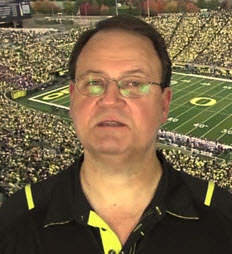
Charles Fischer has been an intense fan of the Ducks, a season ticket holder at Autzen Stadium for 35 years and has written reports on football boards for over 23 years. Known as “FishDuck” on those boards, he is acknowledged for providing intense detail in his scrimmage reports and in his Xs and Os play analyses. He and his wife Lois, have a daughter Christine, reside in Eugene Oregon, where he was a Financial Advisor for 36 years and now focuses full-time on Charitable Planned Giving Workshops for churches and non-profit organizations.
He does not profess to be a coach or analyst, but simply a “hack” that enjoys sharing what he has learned and invites others to correct or add to this body of Oregon Football! See More…


